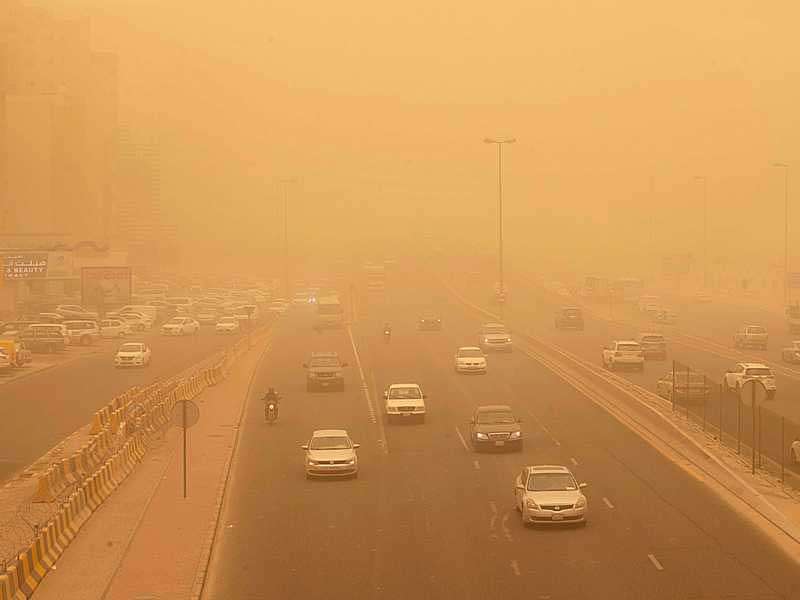Latest News
- Kuwait-Jordan Durra Field Joint Statement Rejected By Iran
- GTD Cracks Down On Vehicle Noise Pollution In Sulaibiya
- Mystery Of Dead Fish At Shuwaikh Beach Sparks Urgent Action
- MEW To Complete Links With The Interior And Justice Ministries B...
- 8 Expats Jailed For Bribing An Officer To Obtain Driver's Licens...
- Weekend Weather Is Expected To Be Hot
- From Tomorrow, Traffic Diversion On Third Ring Road
- Ministry Of Health Refute Rumors On Non-availability Of Antibiot...
- Amir Of Kuwait And Jordan King Renew Commitment To Regional Secu...
- 37 Arrested With Narcotics And Firearms
- Outrage Over Candidate's Arrest
- Six Stores Shut Down In Jahra For Selling Fake Goods
Wmo: Human Health Is At Risk From Sandstorms

Sandstorms have overtaken the Middle East in recent days, phenomena that scientists fear may spread as a result of climate change, endangering human health. In Iraq, where eight sandstorms have covered the country since mid-April, at least 4,000 people rushed to hospitals on Monday for respiratory concerns. More than 5,000 people were hospitalized in Iraqi hospitals earlier this month for similar respiratory illnesses.
Iran, Kuwait, Saudi Arabia, and the United Arab Emirates have all been affected by the phenomena, with more expected in the following days.
Strong winds may propel significant volumes of sand and dust into the sky, where they can travel hundreds, if not thousands, of kilometres.
Sandstorms have impacted 150 nations and regions, wreaking havoc on the environment, health, and economy, according to the World Meteorological Organization.
Carlos Perez Garcia-Pando, a sand and dust storm expert at the Barcelona Supercomputing Center and the Catalan Institution for Research and Advanced Studies, stated, "It's a phenomenon that is both local and worldwide, with a higher intensity in places of origin."
North Africa, the Arabian Peninsula, Central Asia, and China are all experiencing dry or semi-dry weather. Australia, the Americas, and South Africa are among the least impacted regions.
Airborne dust poses "severe hazards," according to the UN agency WMO.
Fine dust particles may cause health issues including asthma and cardiovascular disease, as well as transmit germs, viruses, pesticides, and other poisons.
The WMO said that "dust particle size is a critical predictor of possible human health hazards." Small particles are as small as 10 micrometres can become lodged in the nose, mouth, and upper respiratory tract, causing respiratory problems including asthma and pneumonia.
The elderly and children, as well as those with respiratory and heart disorders, are the most vulnerable.
Residents in nations often pounded by sandstorms are the most impacted, unlike in Europe, where dust from the Sahara is uncommon, as was the case in March. Sand dust may stay in the sky for several days and travel considerable distances, collecting up germs, pollen, and other contaminants depending on the weather and climatic conditions.
"However, the severity is less than with ultrafine particles, which may infiltrate the brain or the circulatory system, such as those found in road traffic," says Thomas Bourdrel, a radiologist and member of the Air Health Climate collective.
Even while sand particles are less harmful than combustion particles, their "extreme density during storms causes a rather considerable increase in cardio-respiratory mortality, especially among the most vulnerable," he explained. "It's virtually unbeatable" with "a concentration of thousands of cubic micrometres in the air," Garcia-Pando remarked.
According to some experts, climate change may increase the frequency and intensity of sandstorms.
Trending News
-
 Kuwait Implements Home Biometrics Services Ahead O...
14 April 2024
Kuwait Implements Home Biometrics Services Ahead O...
14 April 2024 -
 Kuwait Airways Provides Update On Flight Schedule...
14 April 2024
Kuwait Airways Provides Update On Flight Schedule...
14 April 2024 -
 Kuwait Airways Introduces Convenient Home Luggage...
15 April 2024
Kuwait Airways Introduces Convenient Home Luggage...
15 April 2024 -
 Expat Residency Law Amended By Kuwait Ministerial...
20 April 2024
Expat Residency Law Amended By Kuwait Ministerial...
20 April 2024 -
 Two Expats Are Arrested For Stealing From Salmiya...
17 April 2024
Two Expats Are Arrested For Stealing From Salmiya...
17 April 2024 -
 An Egyptian Expat Dies At Kuwait's Airport
11 April 2024
An Egyptian Expat Dies At Kuwait's Airport
11 April 2024 -
 Kuwait Airways Resumes Flights To Beirut And Oman...
15 April 2024
Kuwait Airways Resumes Flights To Beirut And Oman...
15 April 2024 -
 Bay Zero Water Park Kuwait: Summer Season Opens Ei...
11 April 2024
Bay Zero Water Park Kuwait: Summer Season Opens Ei...
11 April 2024 -
 Temperature Increases Cause Electricity Load Index...
21 April 2024
Temperature Increases Cause Electricity Load Index...
21 April 2024 -
 Thief Returns Stolen Money With An Apology Letter...
15 April 2024
Thief Returns Stolen Money With An Apology Letter...
15 April 2024












Comments Post Comment